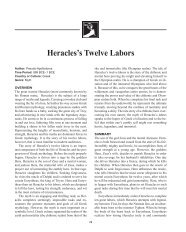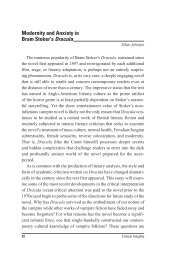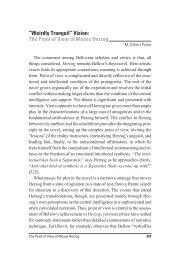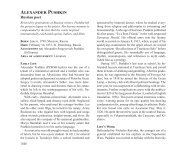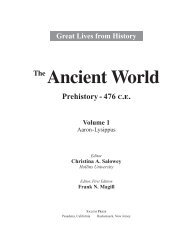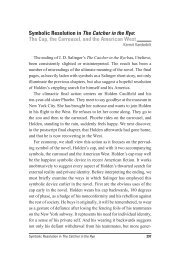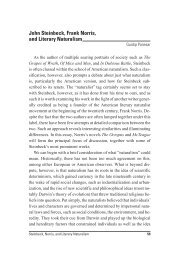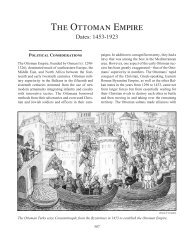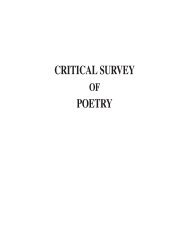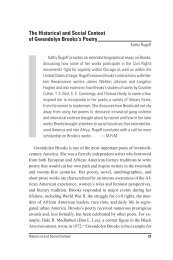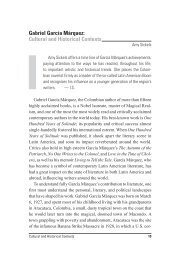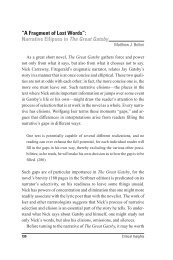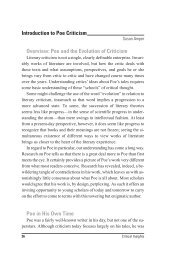Truman Capote - Salem Press
Truman Capote - Salem Press
Truman Capote - Salem Press
Create successful ePaper yourself
Turn your PDF publications into a flip-book with our unique Google optimized e-Paper software.
evening. He soon learns that Holly plays host to a<br />
wide assortment of mostly male friends, ranging<br />
from soldiers to Hollywood agents to an occasional<br />
gangster. Holly also is a regular visitor to Sing Sing<br />
Prison, where she is a paid messenger for a gangster<br />
named Sally Tomato. Holly is a vivacious blond<br />
who speaks in a kind of butchered French-English,<br />
which is her attempt at city sophistication.<br />
Holly fascinates everyone who meets her: the<br />
young writer, her former agent, the bar owner, a<br />
rich playboy named Rusty Trawler, and a handsome<br />
Brazilian, Jose Ybarra-Jaegar, whom she<br />
hopes to marry. Holly is, in effect, a kind of freespirited<br />
earth goddess, the kind of myth men tend<br />
to worship, a myth suggested by the wooden carving<br />
in the story’s opening. The freedom to love as<br />
one desires is one of Holly’s obsessions. She tells<br />
the narrator that she believes people should be allowed<br />
to marry as they like, either male or female.<br />
In another conversation, she expresses her openminded<br />
attitude toward lesbians and even considers<br />
taking in a lesbian roommate. She further reveals<br />
that she is attracted to older men (such as<br />
Wendell Willkie) but that she could as easily be interested<br />
in, ideally, Greta Garbo.<br />
The novella is a slowly unfolding character study<br />
of Holly through a series of episodic events: her<br />
parties; her free lifestyle; her taking in a model,<br />
Mag Wildwood, as a roommate; the visit of her<br />
older Texas husband, Doe; her aspirations to<br />
marry the rich Brazilian Ybarra-Jaegar; and her arrest<br />
and scandal because of her associations with<br />
Sally Tomato. Most important of all these casually<br />
related events is the sudden death of Holly’s<br />
brother, Fred, killed in overseas combat. Faced<br />
with scandal and the end of her planned marriage,<br />
Holly, at the end of the story, leaves New York,<br />
abandoning her only commitment—the pet cat<br />
with no name—and heads to South America to<br />
seek further that glamorous place of safety for<br />
which she yearns.<br />
The book’s title is a symbol of that search; Holly<br />
likes the environment of Tiffany’s jewelry store in<br />
New York, because nothing bad (she thinks) could<br />
happen to anyone there. A quiet, assured place of<br />
the security, wealth, and glamour—a place of calm<br />
belonging—that Holly so desperately seeks, she<br />
sees it as an alternative to the despair that grips<br />
her, the depression she calls the “mean reds.” Although<br />
frivolous and exasperating to those who<br />
know her, Holly Golightly (her name obviously suggests<br />
her attitude toward life) captivates all who<br />
meet her so that, in their minds, she takes on the<br />
substance of an elusive mythic dream, her appeal<br />
carved in their memories just as it was in the African<br />
wooden figure.<br />
In Cold Blood<br />
First published: 1966<br />
Type of work: Nonfiction novel<br />
<strong>Truman</strong> <strong>Capote</strong><br />
A Kansas farm family is mysteriously<br />
murdered by two ex-convicts who flee the scene but<br />
are eventually captured, tried, and executed.<br />
In Cold Blood was created as a work of deliberate literary<br />
experiment. Having written extensive journalistic<br />
coverage in his account of an opera company’s<br />
tour of the Soviet Union (The Muses Are<br />
Heard) and in various travel writing, <strong>Capote</strong> desired<br />
to combine the reportorial techniques of<br />
journalism—the gathering of detailed factual material<br />
by observation and interviewing—with the<br />
narrative and dramatic scene devices of fiction.<br />
The grisly, senseless murders of a Kansas farm family<br />
(Herbert W. Clutter, his wife, and two children)<br />
on November 15, 1959, in Holcomb, Kansas, provided<br />
the opportunity for the writer to try his experiment.<br />
In Cold Blood is a documented record of those<br />
murders, but it is also a documentation of the backgrounds,<br />
motives, attitudes, and perspectives of<br />
hundreds of local townspeople as well as those of<br />
the two killers, ex-convicts Richard Eugene Hickock<br />
and Perry Smith, who are arrested eventually<br />
for the crime, tried, and executed. Shortly after the<br />
crime was committed, <strong>Capote</strong> went to Kansas to<br />
begin the massive accumulation of material that<br />
forms the substance of the book. At the outset, the<br />
murders were baffling because of the lack of any<br />
apparent motive for the slayings. There also were<br />
few clues.<br />
Initially <strong>Capote</strong> envisioned his work as a short<br />
one in which he would explore the background of<br />
the murders and the reaction of the town to them.<br />
With the discovery, capture, and confession of the<br />
two killers, however, <strong>Capote</strong>’s concept changed fo-<br />
403



